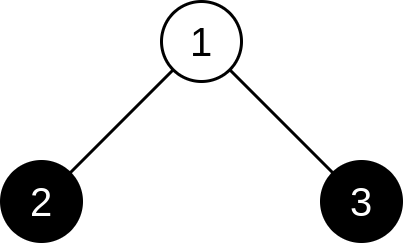CF1646D.Weight the Tree
普及/提高-
通过率:0%
AC君温馨提醒
该题目为【codeforces】题库的题目,您提交的代码将被提交至codeforces进行远程评测,并由ACGO抓取测评结果后进行展示。由于远程测评的测评机由其他平台提供,我们无法保证该服务的稳定性,若提交后无反应,请等待一段时间后再进行重试。
题目描述
You are given a tree of n vertices numbered from 1 to n . A tree is a connected undirected graph without cycles.
For each i=1,2,…,n , let wi be the weight of the i -th vertex. A vertex is called good if its weight is equal to the sum of the weights of all its neighbors.
Initially, the weights of all nodes are unassigned. Assign positive integer weights to each vertex of the tree, such that the number of good vertices in the tree is maximized. If there are multiple ways to do it, you have to find one that minimizes the sum of weights of all vertices in the tree.
输入格式
The first line contains one integer n ( 2≤n≤2⋅105 ) — the number of vertices in the tree.
Then, n−1 lines follow. Each of them contains two integers u and v ( 1≤u,v≤n ) denoting an edge between vertices u and v . It is guaranteed that the edges form a tree.
输出格式
In the first line print two integers — the maximum number of good vertices and the minimum possible sum of weights for that maximum.
In the second line print n integers w1,w2,…,wn ( 1≤wi≤109 ) — the corresponding weight assigned to each vertex. It can be proven that there exists an optimal solution satisfying these constraints.
If there are multiple optimal solutions, you may print any.
输入输出样例
输入#1
4 1 2 2 3 2 4
输出#1
3 4 1 1 1 1
输入#2
3 1 2 1 3
输出#2
2 3 1 1 1
输入#3
2 1 2
输出#3
2 2 1 1
输入#4
9 3 4 7 6 2 1 8 3 5 6 1 8 8 6 9 6
输出#4
6 11 1 1 1 1 1 1 1 3 1
说明/提示
This is the tree for the first test case:
 In this case, if you assign a weight of 1 to each vertex, then the good vertices (which are painted black) are 1 , 3 and 4 . It impossible to assign weights so that all vertices are good vertices. The minimum sum of weights in this case is 1+1+1+1=4 , and it is impossible to have a lower sum because the weights have to be positive integers.This is the tree for the second test case:
In this case, if you assign a weight of 1 to each vertex, then the good vertices (which are painted black) are 1 , 3 and 4 . It impossible to assign weights so that all vertices are good vertices. The minimum sum of weights in this case is 1+1+1+1=4 , and it is impossible to have a lower sum because the weights have to be positive integers.This is the tree for the second test case:
 In this case, if you assign a weight of 1 to each vertex, then the good vertices (which are painted black) are 2 and 3 . It can be proven that this is an optimal assignment.
In this case, if you assign a weight of 1 to each vertex, then the good vertices (which are painted black) are 2 and 3 . It can be proven that this is an optimal assignment.